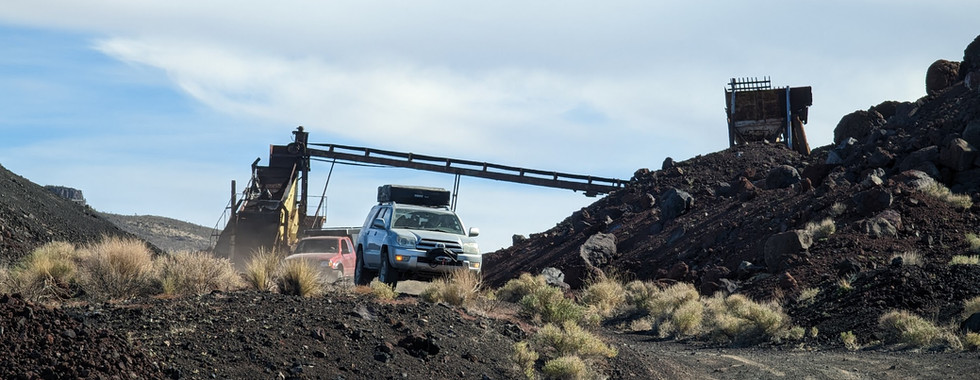East Mojave Heritage Trail
- OTG Crew
- Nov 11, 2022
- 9 min read
Updated: Feb 4
The East Mojave Heritage Trail is an epic 700+ mile adventure through some of the lesser traveled areas within the East Mojave Desert and Mojave National Preserve. While the Mojave Road seems to get all the glory in these parts, the much longer EMHT is action packed with geological wonders and interesting history and sights around just about every corner.
Route Overview
Trip Length & Season
Adventure Rating: Baja
Trip Length: 7-14 days, approximately 740 miles
Season: October through May, but late winter to early spring tends to bring mild temps with more greenery and desert blooms. Summer travel is not advised as desert temps can exceed 110F.
Digital Maps & GPX Files
Technical Ratings & Terrain
Recommended Vehicle / Moto / Adventure Vans
Fuel, Provisions, and Recommended Gear
Alternative Routes
Camping Recommendations
Discovery Points & EMHT Mailboxes
Land Managers & Other Resources
Permits & Papers
Adventure Badges: EMHT Decals and Patches are now available to purchase at the MDHCA store.
Route Details
The East Mojave Heritage Trail was developed in the 1980s as an alternate overland route to the better-known (and much shorter) Mojave Road by Dennis Casebier. Even back then, the Mojave Road was seeing a reasonable amount of vehicle traffic. Casebier's goal with the East Mojave Heritage Trail was to disperse vehicle traffic throughout the East Mojave region while also introducing travelers to its lesser-visited areas. As he did with the Mojave Road, Casebier created a series of guidebooks—one for each of the four segments of the EMHT—containing detailed information about the region’s past, mining history, railroads, industrial developments, quirky stories, geology, flora, and fauna. We highly recommend purchasing the guidebooks given the wealth of information they contain. However, it's important to note that the current iteration of the East Mojave Heritage Trail has been revised and updated to bypass wilderness boundaries that were implemented after Casebier’s guidebooks were published.
The four segments of the East Mojave Heritage Trail largely sit within the 1.5 million acres of the Mojave National Preserve. The route visits well-known locations like Kelso Dunes, as well as many places off the beaten path. Given the length of the trail and the existence of Casebier’s guidebooks, OTG’s route guide provides a general overview of what to expect while exploring the EMHT. We encourage all travelers to purchase the guidebooks to gain the most informative experience. The East Mojave Heritage Trail is broken down into four distinct segments:
Segment 1: Needles to Ivanpah – 173 miles
Segment 2: Ivanpah to Rocky Ridge – 199 miles
Segment 3: Rocky Ridge to Fenner – 211 miles
Segment 4: Fenner to Needles – 155 miles
Each segment has a unique character and history. Segments 1 and 2 are rich with mining history. Segment 2 also features volcanic landscapes like the cinder cone lava fields. Segment 3 showcases unique geological features such as Kelso Dunes, Hole-in-the-Wall, and Mitchell Caverns. Segment 4 tends to focus on the natural and geological history of the East Mojave. Needless to say, there’s something for everyone along the EMHT—whether you're into stargazing, hiking, exploring local flora and fauna, spelunking, or learning about early pioneers and the Indigenous peoples who once called this part of the Mojave home.
We spent hours poring over the four guidebooks, translating the wealth of information from Dennis Casebier into over 100 discovery points. These points lead to locations such as old townsites, mining camps and cabins, caves, lava fields, unique geological formations, and strange desert oddities—like the Mojave Megaphone. We’ve also included a number of discovery points that aren’t mentioned in Casebier’s guidebooks but are relevant to telling the story of the East Mojave. We hope you enjoy the research and hard work that went into developing the most complete digital mapping file available for the East Mojave Heritage Trail!
The nearly forgotten East Mojave Heritage Trail was recently resurrected by Billy Creech, who spent countless hours exploring the desert to create an updated version of the EMHT. With its rebirth, the EMHT is poised to become one of North America's iconic overland routes.
Rebirth of the East Mojave Heritage Trail
Dennis Casebier spent years exploring the desert and writing his Mojave Road and East Mojave Heritage Trail guidebooks. He was aware of the possibility that wilderness research areas could cut off vehicular access to parts of the EMHT—which is exactly what happened shortly after the guidebooks were published in the early 1990s, making through-passage impossible on certain segments. Aside from a handful of desert rats, history buffs, and off-road misfits who still traveled the EMHT, the route was largely forgotten. That is, until Billy Creech came across the guidebooks and began exploring the original tracks, researching, and developing new routes to bypass wilderness areas and trail closures.
Hailing from Southern California and now based in southwest Idaho, Billy grew up enjoying the outdoors. His first remote exploration trip was in the ’80s, when he joined his girlfriend’s family in their Scout on a trip to Death Valley. A certified Master Diver, he has worked in water search and rescue and is now a corporate supply chain strategist and planning professional. His passion for outdoor exploration, hiking, and camping evolved into overland exploration and eventually scientific expeditions. He is happiest when exploring remote areas—sharing skills, enjoying nature, meeting people, and making new friends while cooking over an open fire and swapping stories.
Billy is an elected member of The Explorers Club and is considered a subject matter expert on exploration, particularly in desert environments. He holds an MBA from Cornell University, serves as the President of the Board of Directors for the Mojave Desert Heritage & Cultural Association, and is a published author and poet. He is also a frequent guest on various exploration podcasts and a two-time recipient of the Mojave Road Wagon Master Award.
Gallery
Terms of Use: Should you decide to travel a route that is published on Overlandtrailguides.com, you do so at your own risk. Always take the appropriate precautions when planning and traveling, including checking the current local weather, permit requirements, trail/road conditions, and land/road closures. While traveling, obey all public and private land use restrictions a
nd rules, and carry the appropriate safety, recovery, and navigational equipment. The information found on this site is simply a planning resource to be used as a point of inspiration in conjunction with your own due-diligence. In spite of the fact that this route, associated GPS track (GPX and maps), and all route guidelines were prepared under diligent research by Overland Trail Guides, the route accuracy and current conditions of roads and trails cannot be guaranteed.




































































Comments